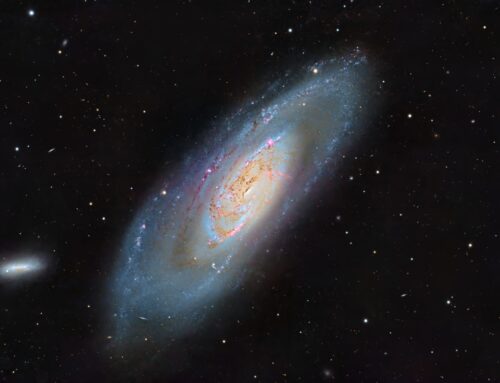Comet C/2022 E3 (ZTF)
 Click image for full size version
Click image for full size version
February 13, 2023
I captured this comet from my home in Guelph, Ontario on the first clear night we have had in months. There’s tons of information about this comet along with loads of information; just look it up online. My image shows it well past its best, but nice nonetheless. The green glow is mainly from diatomic carbon in the head of the coat. Enjoy!
Tekkies:
Acquisition, focusing, and control of Paramount MX mount with N.I.N.A., and TheSkyX. Focus with Optec DirectSync motors and controller. Equipment control with PrimaLuce Labs Eagle 4 Pro computer. All pre-processing and processing in PixInsight. Acquired from my SkyShed in Guelph. Very good transparency and average seeing. Acquired February 11, 2023, under a moonless sky.
Tak FSQ-106 @ f/5 (530mm), QHY-367C Pro One-shot colour with Optolong UV/IR filter
Image scale 1.9 arcsec per pixel
The WeightedBatchPreProcessing script was used to perform calibration, cosmetic correction, weighting, registration, local normalization, integration and Drizzle integration of all frames.
DynamicBackgroundExtraction was applied to the master.
ColorCalibration was used to colour-calibrate the master.
Initial Processing
Stars-only image: StarXterminator was used to remove the stars from the WBPP-produced master. The stars-only image was retained for use later; the starless image was discarded.
Comet-only image: StarXterminator was applied in batch mode to the registered frames from WBPP. The starless registered images were aligned on the comet using CometAlignment, and the comet-aligned frames were integrated with ImageIntegration.
Combining Star and Comet Images: PixelMath was used to add the star-only and comet-only images together.
Deconvolution: BlurXterminator was applied with a custom psf FWHM determined with the PSFImage script, and star sharpening set to 0.08.
Linear Noise Reduction: NoiseXterminator was applied to with settings Amount=0.9 and Detail=0
Stretching: HistogramTransformation was applied to each image to make a pleasing image with a background brightness of about 0.10 in each channel.
Additional Processing
Star Removal: StarXterminator was used to remove the stars.
Nonlinear Noise Reduction: NoiseXterminator was used to reduce noise in the background areas of the image with settings Amount=0.9 and Detail=0.25
Contrast Enhancement: HDRMultiscaleTransform was applied to a clone of the image and the result blended 50:50 with the original through a mask that selected only the head of the comet. ExponentialTransformation was applied through a mask to reveal the ion tail (Power of Inverted Pixels, amount 0.2).
Star Restoration: Stars removed using StarXterminator were added back into the image using straight addition in PixelMath.
Final Steps: Background, comet and star brightness, contrast, hue, and saturation were adjusted in several iterations using CurvesTransformation with masks as required. ICCProfileTransformation (sRGB IEC61966-2.1; Relative Colorimetric with black point compensation) was applied prior to saving as a jpg.






Absolutely gorgeous image, like always!
Stunning, Ron. I took a shot at it with only my DSLR while I’m down here in Costa Rica (after we moved from Belwood) with extremely limited equipment. I can hardly wait to get my mount shipped down here. What a pleasure to see your work.